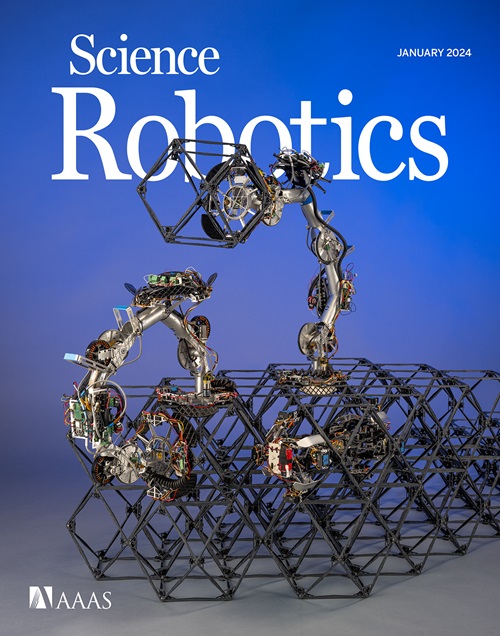RoboBallet:基于图神经网络和强化学习的多机器人到达规划
IF 27.5
1区 计算机科学
Q1 ROBOTICS
引用次数: 0
摘要
现代机器人制造要求多个机器人在共享的、充满障碍物的工作空间中无碰撞地协调完成众多任务。尽管单独的任务可能很简单,但在时空约束下的自动联合任务分配、调度和运动规划对于现实世界尺度的经典方法来说仍然难以计算。在工业中部署的现有多臂系统依靠人类的直觉和经验来手动设计可行的轨迹,这是一个劳动密集型的过程。为了应对这一挑战,我们提出了一个强化学习(RL)框架来实现自动化任务和运动规划,在一个充满障碍物的环境中进行测试,在一个共享工作空间中,8个机器人执行40个到达任务,其中任何机器人都可以以任何顺序执行任何任务。我们的方法建立在通过RL训练的图神经网络(GNN)策略上,该策略在程序生成的环境中具有不同的障碍布局、机器人配置和任务分布。它使用场景的图表示和经过强化学习训练的图策略神经网络生成多个机器人的轨迹,共同解决任务分配、调度和运动规划等子问题。在模拟中训练大型随机生成的任务集,我们的策略将零射击推广到具有不同机器人位置,障碍物几何形状和任务姿势的未见设置。我们进一步证明,我们的解决方案的高速功能使其能够用于工作单元布局优化,从而缩短解决时间。我们的规划器的速度和可伸缩性还为容错规划和基于在线感知的重新规划等功能打开了大门,这些功能需要对动态任务集进行快速适应。本文章由计算机程序翻译,如有差异,请以英文原文为准。
RoboBallet: Planning for multirobot reaching with graph neural networks and reinforcement learning
Modern robotic manufacturing requires collision-free coordination of multiple robots to complete numerous tasks in shared, obstacle-rich workspaces. Although individual tasks may be simple in isolation, automated joint task allocation, scheduling, and motion planning under spatiotemporal constraints remain computationally intractable for classical methods at real-world scales. Existing multiarm systems deployed in industry rely on human intuition and experience to design feasible trajectories manually in a labor-intensive process. To address this challenge, we propose a reinforcement learning (RL) framework to achieve automated task and motion planning, tested in an obstacle-rich environment with eight robots performing 40 reaching tasks in a shared workspace, where any robot can perform any task in any order. Our approach builds on a graph neural network (GNN) policy trained via RL on procedurally generated environments with diverse obstacle layouts, robot configurations, and task distributions. It uses a graph representation of scenes and a graph policy neural network trained through RL to generate trajectories of multiple robots, jointly solving the subproblems of task allocation, scheduling, and motion planning. Trained on large randomly generated task sets in simulation, our policy generalizes zero-shot to unseen settings with varying robot placements, obstacle geometries, and task poses. We further demonstrate that the high-speed capability of our solution enables its use in workcell layout optimization, improving solution times. The speed and scalability of our planner also open the door to capabilities such as fault-tolerant planning and online perception-based replanning, where rapid adaptation to dynamic task sets is required.
求助全文
通过发布文献求助,成功后即可免费获取论文全文。
去求助
来源期刊

Science Robotics
Mathematics-Control and Optimization
CiteScore
30.60
自引率
2.80%
发文量
83
期刊介绍:
Science Robotics publishes original, peer-reviewed, science- or engineering-based research articles that advance the field of robotics. The journal also features editor-commissioned Reviews. An international team of academic editors holds Science Robotics articles to the same high-quality standard that is the hallmark of the Science family of journals.
Sub-topics include: actuators, advanced materials, artificial Intelligence, autonomous vehicles, bio-inspired design, exoskeletons, fabrication, field robotics, human-robot interaction, humanoids, industrial robotics, kinematics, machine learning, material science, medical technology, motion planning and control, micro- and nano-robotics, multi-robot control, sensors, service robotics, social and ethical issues, soft robotics, and space, planetary and undersea exploration.
 求助内容:
求助内容: 应助结果提醒方式:
应助结果提醒方式:


